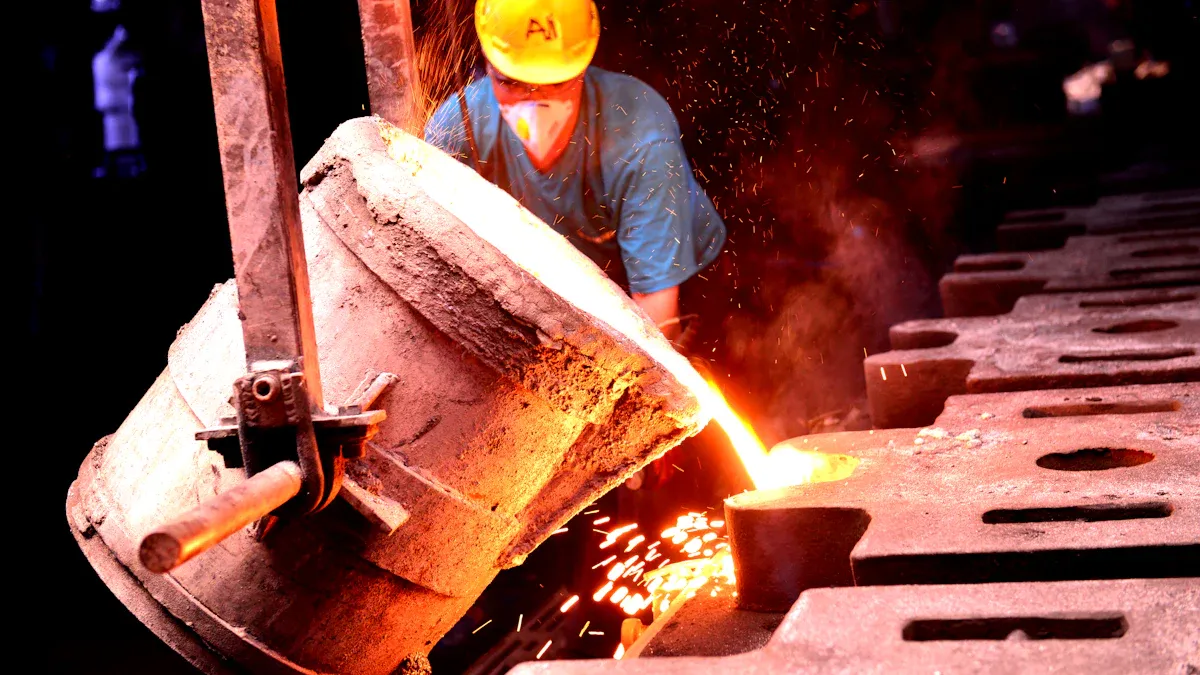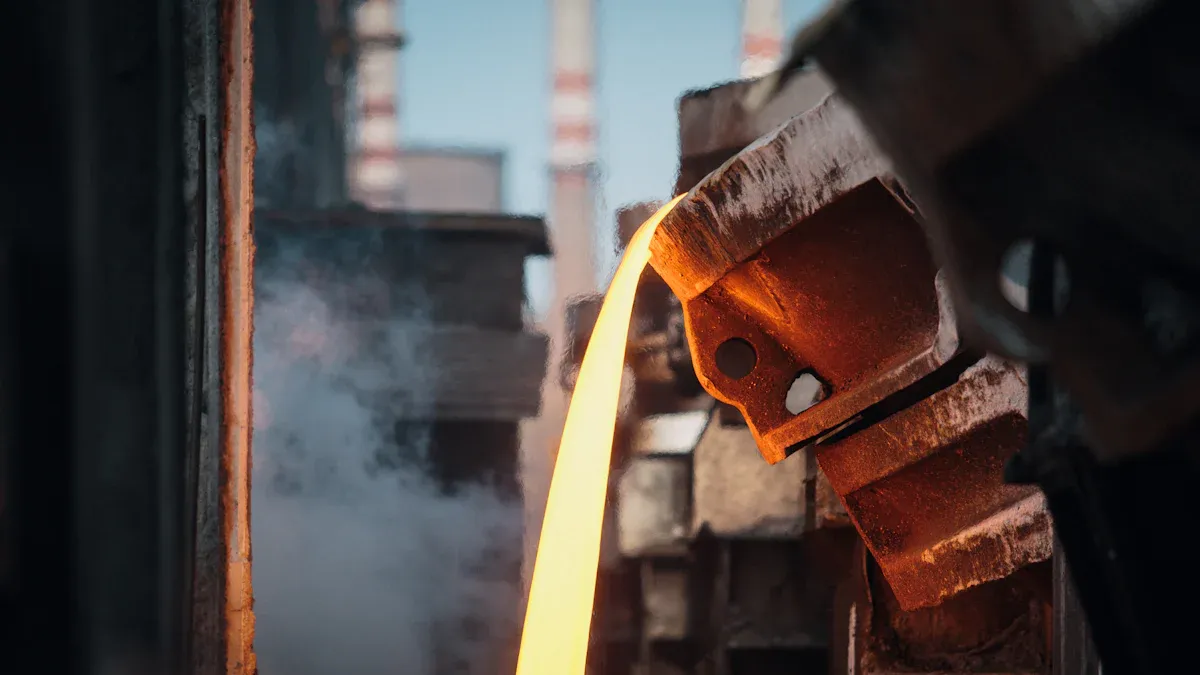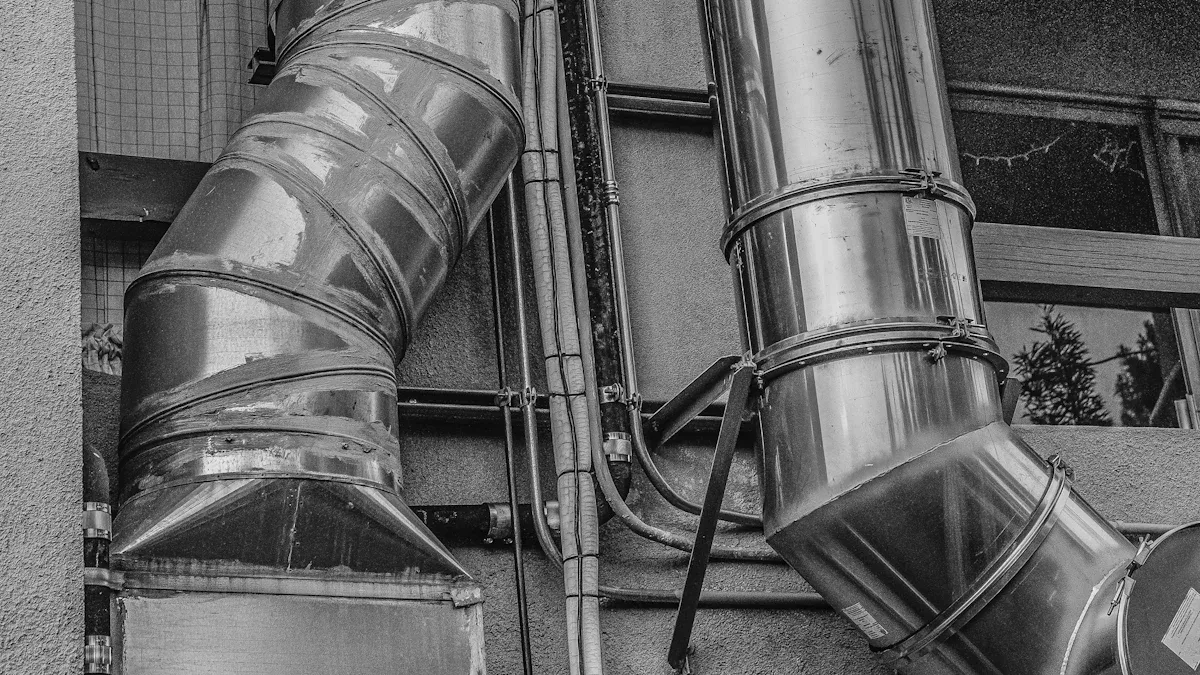
Stainless steel casting for exhaust outlet connection ensures exceptional durability and performance. Components crafted through this process, including 304 stainless steel precision castings, exhibit:
- Resistance to corrosion in harsh environments.
- High-temperature endurance without structural compromise.
- Longevity, reducing maintenance needs.
316 stainless steel investment castings, known for their precision and strength, deliver unmatched reliability in demanding exhaust systems, making them an ideal choice for high-performance applications.
Key Takeaways
- Stainless steel casting, like 316L stainless steel, resists rust very well. This makes it great for exhaust systems in tough conditions.
- Investment casting is precise and flexible. It helps make detailed shapes that fit exact sizes needed for exhaust outlets.
- Stainless steel castings are strong and handle heat well. They need less fixing and last a long time in hard jobs.
What is Stainless Steel Casting for Exhaust Outlet Connection?
Definition and Importance
Stainless steel casting for exhaust outlet connection refers to the process of shaping stainless steel into precise components that meet the demanding requirements of exhaust systems. This method ensures the production of parts that can withstand extreme conditions, including high temperatures and corrosive environments. The importance of this process lies in its ability to create durable, high-performance components essential for maintaining the efficiency and longevity of exhaust systems.
Exhaust outlet connections require materials that resist rust and maintain structural integrity under thermal stress. Stainless steel casting achieves this by offering exceptional precision and adaptability, making it the preferred choice for manufacturing these critical components.
Types of Stainless Steel Casting
Investment Casting
Investment casting, also known as precision casting, is a highly accurate method used for creating complex shapes with tight tolerances. The process involves several steps, as outlined below:
| Step | Description |
|---|---|
| 1 | Wax Model Creation: Inject wax into a mold to create a model of the desired part. |
| 2 | Shell Formation: Coat the wax model with a refractory ceramic material to form a shell. |
| 3 | Wax Removal: Melt the wax in an oven, leaving a hollow ceramic mold. |
| 4 | Pouring: Pour molten stainless steel into the ceramic mold. |
| 5 | Cooling: Allow the stainless steel to cool and solidify. |
| 6 | Shell Removal: Remove the ceramic shell to reveal the cast part. |
| 7 | Finishing: Cut and finish the part to ensure it meets specifications. |
| 8 | Testing: Conduct tests to ensure quality and integrity of the part. |
This method delivers excellent surface finishes and high precision, making it ideal for exhaust outlet connections that require intricate designs.
Sand Casting
Sand casting is a more economical method, often used for larger components. It involves creating a mold from sand and pouring molten stainless steel into it. While this method is cost-effective, it offers lower precision and a rougher surface finish compared to investment casting. For exhaust outlet connections, sand casting is less suitable due to its inability to meet the tight tolerances required.
| Casting Method | Precision | Surface Finish | Suitability for Exhaust Outlets |
|---|---|---|---|
| Investment Casting | High precision | Excellent surface finish | Preferred for complex parts with tight tolerances |
| Sand Casting | Lower precision | Rougher surface finish | Economical for larger components, less suitable for tight tolerances |
Both methods have their applications, but investment casting remains the superior choice for stainless steel casting for exhaust outlet connection due to its precision and adaptability.
Why 316L Stainless Steel is the Best Choice for Exhaust Outlet Connections
Material Composition of 316L Stainless Steel
316L stainless steel is a low-carbon alloy with a carefully balanced composition that enhances its performance in demanding environments. Its primary elements include:
- Chromium (16.0–18.0%): Provides excellent corrosion resistance.
- Nickel (10.0–14.0%): Improves ductility and resistance to oxidation.
- Molybdenum (2.0–2.5%): Enhances resistance to pitting and crevice corrosion.
- Carbon (≤ 0.030%): Reduces carbide precipitation, ensuring superior weldability.
Other elements, such as manganese, silicon, and phosphorus, contribute to its mechanical strength and durability. This composition makes 316L stainless steel ideal for applications like exhaust outlet connections, where exposure to high temperatures and corrosive gases is common.
| Element | Composition (wt.%) |
|---|---|
| Carbon (C) | ≤ 0.030 |
| Chromium (Cr) | 16.0 – 18.0 |
| Iron (Fe) | Balance |
| Manganese (Mn) | 2.0 – 2.5 |
| Molybdenum (Mo) | 2.0 – 2.5 |
| Nickel (Ni) | 10.0 – 14.0 |
| Phosphorus (P) | ≤ 0.045 |
| Silicon (Si) | ≤ 0.75 |
| Sulfur (S) | ≤ 0.030 |
Key Features and Advantages
Corrosion Resistance
316L stainless steel offers exceptional resistance to rust and corrosion, even in harsh environments. Its high chromium and molybdenum content protect against pitting and crevice corrosion, making it suitable for exhaust systems exposed to moisture and chemicals.
High-Temperature Durability
This alloy maintains its mechanical properties at elevated temperatures. It withstands heat up to 1700°C, ensuring structural integrity in exhaust outlet connections subjected to extreme thermal stress.
Ease of Welding
The low carbon content minimizes the risk of carbide precipitation during welding. This feature ensures that welded joints remain resistant to corrosion, enhancing the overall reliability of the component.
Longevity and Strength
316L stainless steel combines strength with durability. Its resistance to wear and tear reduces the need for frequent replacements, lowering maintenance costs over time.
Aesthetic and Maintenance Benefits
The smooth surface of 316L stainless steel simplifies cleaning and maintenance. Its attractive finish also enhances the visual appeal of exhaust system components, making it a preferred choice for high-performance applications.
| Advantage | Description |
|---|---|
| Excellent Corrosion Resistance | Highly resistant to rust, especially in corrosive environments. |
| Ability to Withstand High Temperatures | Maintains strength and structure under extreme heat. |
| Ease of Welding | Low carbon content ensures rust-resistant welded joints. |
| Strength and Longevity | Durable and requires less frequent maintenance. |
| Cleanliness and Simple Maintenance | Smooth surface allows for easy cleaning. |
| Attractive Look | Provides a clean, polished finish for exhaust components. |
By combining these features, 316L stainless steel ensures that stainless steel casting for exhaust outlet connection delivers unmatched performance and reliability.
Stainless Steel Investment Casting Process for Exhaust Outlet Connections

Design and Wax Pattern Creation
The investment casting process begins with designing and creating a wax pattern. This pattern serves as an exact replica of the final exhaust outlet connection. Using a master die, manufacturers inject wax to form the model. Advanced techniques, such as 3D printing, enhance precision and compatibility with CAD/CAM systems. These methods allow for the creation of intricate designs with tolerances as precise as 0.005 inches.
| Aspect | Detail |
|---|---|
| Wax Pattern Creation | Exact replica of the final product, produced using a master die. |
| Production Techniques | 3D printing enhances precision and compatibility with CAD/CAM systems. |
| Tolerances | Achievable tolerances as precise as 0.005 inches. |
This step ensures that stainless steel casting for exhaust outlet connection meets the high standards required for durability and performance.
Shell Construction and Wax Elimination
After creating the wax pattern, it is coated with a refractory ceramic material to form a robust shell. The process involves dipping the wax model into ceramic slurry and allowing it to dry. This step is repeated to build a strong shell capable of withstanding molten steel. Once the shell is complete, the wax is melted and removed in a process known as “lost wax casting.” Heating the shell further eliminates any wax residues and strengthens the mold.
- Wax patterns are assembled into a tree structure for efficient casting.
- Ceramic shells are heated to ensure they can endure the high temperatures of molten steel.
- This step guarantees the accuracy and integrity of the final cast part.
Molten Steel Pouring and Solidification
Molten 316L stainless steel is poured into the preheated ceramic shell. Preheating prevents the shell from shattering due to temperature differences. The shell remains hot during pouring to ensure proper filling and reduce defects. After pouring, the steel cools and solidifies, forming the desired exhaust outlet connection.
The pouring process requires precise control of temperature and wall thickness to avoid defects like shrinkage or porosity. For instance, wall thickness should exceed 8mm to prevent cold insulation, while pouring temperature must be adjusted based on casting size.
Finishing and Quality Assurance
Once the steel solidifies, the ceramic shell is removed to reveal the cast part. The part undergoes cutting and finishing to achieve smoothness and accuracy. Quality assurance measures include dimensional checks, visual inspections, and advanced testing methods like X-ray and dye penetrant testing. These steps ensure the exhaust outlet connection meets all specifications and performs reliably in demanding environments.
- Dimensions are measured to confirm adherence to design specifications.
- Surface imperfections are identified and corrected.
- Hidden flaws are detected using specialized testing techniques.
This meticulous process guarantees that stainless steel casting for exhaust outlet connection delivers exceptional quality and durability.
Benefits of Stainless Steel Casting for Exhaust Outlet Connections

Resistance to Corrosion and Rust
Stainless steel casting for exhaust outlet connection provides exceptional resistance to corrosion and rust. This benefit stems from the material’s high chromium and molybdenum content, which forms a protective oxide layer on the surface. A study published in Mater. Res. Express highlights the oxidation behavior of 316L stainless steel under high-temperature air exposure. The findings confirm its ability to maintain structural integrity and resist oxidation over extended periods.
- 316L stainless steel withstands corrosive environments, including salty or chemical-laden conditions.
- Molybdenum enhances rust resistance, ensuring durability in harsh applications.
- Casting processes distribute protective properties uniformly across components, further improving longevity.
These attributes make stainless steel casting a reliable choice for exhaust systems exposed to moisture and corrosive gases.
High-Temperature Performance
Exhaust outlet connections often operate under extreme heat. Stainless steel casting ensures high-temperature performance, with 316L stainless steel demonstrating remarkable stability. Laboratory tests reveal that this alloy resists oxidation effectively up to 700 °C. Hot tensile tests conducted between 700 °C and 900 °C show peak stress and yield stress stability at 700 °C, making it ideal for applications requiring thermal endurance.
- Oxidation resistance remains effective at temperatures up to 700 °C.
- Yield stress remains constant at 700 °C, ensuring structural reliability.
- Lower strain rates at higher temperatures reduce stress, maintaining component integrity.
These properties ensure exhaust outlet connections perform reliably under thermal stress.
Durability and Longevity
Stainless steel casting delivers components with exceptional durability and longevity. The material’s resistance to wear and tear reduces the need for frequent replacements, lowering maintenance costs. Its robust mechanical properties, combined with uniform casting processes, ensure that exhaust outlet connections endure prolonged use without compromising performance.
Stainless steel’s inherent strength and corrosion resistance contribute to its long lifespan, making it a cost-effective solution for exhaust systems.
Precision and Adaptability
Investment casting methods used for stainless steel components achieve tight tolerances essential for complex designs. This precision ensures that exhaust outlet connections meet exact specifications, enhancing their functionality. Stainless steel castings undergo rigorous quality checks, including adherence to ASTM A995 standards, to verify mechanical properties and corrosion resistance.
| Aspect | Detail |
|---|---|
| Method | Investment casting produces durable and accurate components. |
| Tolerances | Achieves tight tolerances essential for complex valve geometries. |
| Mechanical Properties | Corrosion resistance and strength make stainless steel suitable for intricate applications. |
The adaptability of stainless steel casting allows manufacturers to create intricate shapes while maintaining structural integrity, making it ideal for exhaust outlet connections.
Stainless steel casting, especially with 316L stainless steel, offers unmatched reliability for exhaust outlet connections. Its precision and adaptability ensure components meet exact specifications.
- Initial costs may seem higher, but long-term savings outweigh them.
- Durable cast parts reduce repair frequency, lowering maintenance expenses.
- Superior mechanical properties withstand stress and vibrations, ensuring lasting performance.
This process guarantees cost-effective, high-quality solutions for demanding applications.
FAQ
What makes 316L stainless steel suitable for exhaust outlet connections?
316L stainless steel resists corrosion, withstands high temperatures, and offers excellent weldability. Its low carbon content ensures durability and reliability in demanding exhaust system applications.
How does investment casting ensure precision in exhaust outlet connections?
Investment casting creates intricate designs with tight tolerances. The process uses wax patterns and ceramic molds, ensuring components meet exact specifications with superior surface finishes.
Why is corrosion resistance critical for exhaust outlet connections?
Exhaust systems face moisture and chemicals that cause rust. Corrosion-resistant materials like 316L stainless steel ensure longevity and maintain structural integrity in harsh environments.
